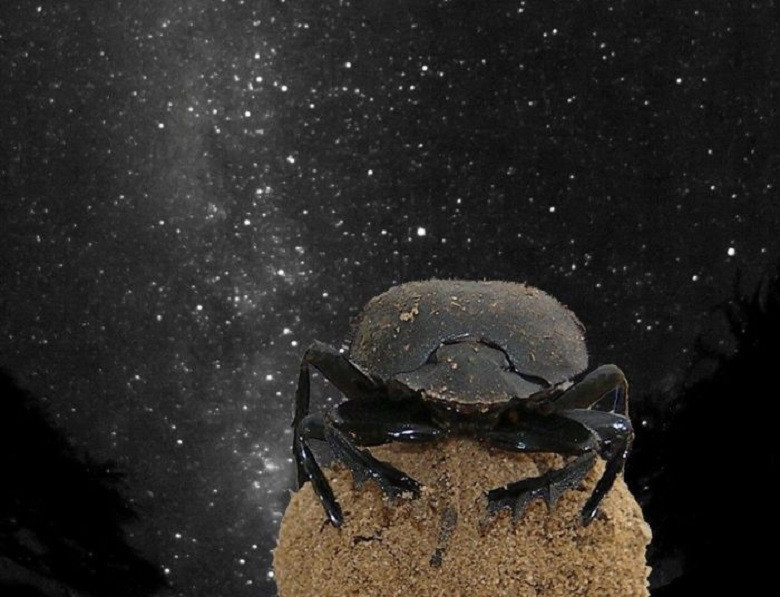Unveiling the Astonishing Navigation Skills of Scarab Beetles
In the vast expanse of the natural world, scarab beetles stand out for their remarkable ability to navigate through the darkness of space, even when the only guiding light is that of the celestial bodies like the Milky Way and clusters of bright stars. Among the diverse inhabitants of our planet, scarab beetles hold a unique distinction as the only insects capable of charting their course based on the positioning of celestial entities in the Galaxy.
The Illuminated Path of Scarab Beetles
Recent studies have shed light on the extraordinary navigational prowess of scarab beetles, revealing their reliance on the light emanating from the Milky Way. This discovery has expanded the roster of creatures, essential for whom is the gleam of stars in the night sky, to include the humble dung beetle alongside birds and seals, known to utilize starlight for orientation. It is intriguing to note that scarab beetles utilize the radiant Milky Way as a navigational beacon, enabling them to deftly roll their prized dung balls away from the heap in a straight line, avoiding potential competition from rival beetles.
The uncanny ability of scarab beetles to roll a dung ball in a precise path even under the cloak of darkness, with a moonless and cloudless sky, prompted a team of biologists from Sweden and South Africa to postulate that these insects draw guidance from the starlit sky.
To test this hypothesis, a circular arena was constructed, featuring a sand-covered level floor with a diameter of 3 meters and a 1-meter-high barrier. Scarabaeus satyrus beetles were released in the center of the arena with dung balls, while their movements were meticulously captured on video to analyze the distances they covered.
While the shortest route to the barrier was 150 cm, beetles wearing visors exhibited an average traversal of 476 cm around the perimeter, compared to 207 cm by those without visors. Transparent plastic replicas of visors were employed to ensure that the beetles' behavior was not influenced by extraneous factors. Strikingly, the scarab beetles visibly altered their trajectory based on whether they were able to perceive the starlit night sky or not, affirming their reliance on stellar cues for navigation.
A Deeper Dive into Scarab Beetle Navigation
In a subsequent experiment, the researchers minimized external stimuli by raising a 2-meter diameter arena above the ground, obscuring the surroundings with a barrier draped in black fabric, and replacing sand with a flat wooden floor. The focus shifted to measuring the speed of scarab beetles as they traversed the distance from a central platform to the arena's edge. Notably, the time taken by the scarabs to cover the designated distance was recorded meticulously to assess their movement patterns under varying conditions - with and without visors and in complete darkness.
The results revealed that under a full moon, scarab beetles took an average of 21.4 seconds to exit the arena, displaying a higher level of confidence in their movements. Conversely, on moonless starry nights, the beetles exhibited a less assured gait, requiring 40 seconds to navigate the same distance. When the beetles were deprived of a view of the night sky using a canopy or lid, their erratic movements and increased looping time of up to 124 seconds underscored their reliance on starlight for orientation. These findings corroborated the hypothesis that scarab beetles possess the remarkable capability to leverage celestial cues for their explorations.
Deciphering the Celestial Guide of Scarab Beetles
The final phase of the experiment transported the arena, scarab beetles, dung balls, and researchers to the city planetarium of Johannesburg, South Africa, for a compelling investigation into the navigational mechanisms of scarab beetles under simulated starry skies. With approximately four thousand stars projected onto the planetarium dome, including a distinct representation of the Milky Way, the researchers scrutinized the behavior of scarab beetles under various celestial configurations.
The observation revealed that scarab beetles consistently required an average of 53 seconds to exit the arena, irrespective of whether they were exposed to a full starry sky with the Milky Way or solely the image of the Milky Way. This consistency in their movement patterns suggested a strong reliance on starlight for their orientation in the absence of moonlight.
Further analysis indicated that when presented with a dimly illuminated Milky Way, scarab beetles displayed slightly improved navigation timing of 65.2 seconds, emphasizing the subtle role of the Milky Way's luminosity in guiding their movements. However, restricting the projection to only the brightest stars extended the beetles' wandering time to 81 seconds, culminating in a prolonged duration of 120 seconds under complete darkness. This conclusive evidence validated the pivotal role played by the gentle glow of the Milky Way in aiding scarab beetles' navigation under starlit skies as they diligently roll their dung balls across the landscape.

In a definitive experiment featuring Scarabeus zambesianus beetles, whose navigational prowess aligns with the summer stars, a crucial observation was made when the Milky Way descended too low above the horizon in October. These scarab beetles altered their rolling trajectory, opting for looping movements instead of a direct path, reaffirming the profound impact of the Milky Way's illumination on their nocturnal travels.
In a scientific consensus, the researchers underscored that the radiant light of the Milky Way serves as a celestial guide for scarab beetles, assisting them in steering through the darkness of moonless nights with impeccable precision and purpose.
The profound discoveries made through these groundbreaking experiments have not only illuminated the remarkable navigational abilities of scarab beetles but have also expanded our understanding of the intricate interplay between celestial phenomena and the bewildering world of insect intelligence.














Comments
0 comment